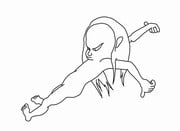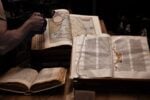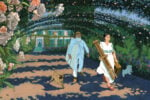Koo Jeong A – Void within unlimited freedom

BASE / Progetti per l’arte presenta un progetto site-specific realizzato appositamente dall’artista di origine coreana Koo Jeong A per lo spazio non profit di Firenze.
Comunicato stampa
BASE / Progetti per l’arte presenta un progetto site-specific realizzato appositamente dall’artista di origine coreana Koo Jeong A per lo spazio non profit di Firenze.
Void within unlimited freedom è una mostra inedita di Koo Jeong A con la quale l’artista si propone di scoprire la città di Firenze e lo spazio di BASE / Progetti per l’arte durante una breve residenza di una settimana, quella precedente l’inaugurazione. Il frammento temporale preso in questione, che è il vero soggetto del progetto, sarà sintetizzato, espanso ed evocato all’interno dello spazio espositivo attraverso interventi tanto minimali, quanto coinvolgenti emotivamente. Questa modalità scelta dall’artista è pensata non per realizzare un prodotto fine a sé stesso, bensì come mezzo con cui aprire una discussione collettiva sul valore e sul senso dell’attenzione verso il quotidiano e rispetto alla pratica dell’incontro (nell’era del villaggio globale). Gli indizi per intuire che tipo di processo sarà attivato dalla mostra di Koo consistono, per adesso, in una lista di desideri da verificare ed esperire in loco: “Visitare il convento di San Marco; incontrare gli artisti di BASE; realizzare un libro/diario dell’esperienza; ripensare al rapporto con l’Oriente; guardare il fiume Arno; creare dei timbri in gomma per stampare una serie di disegni; vedere cosa accade…”. Nelle opere di Koo Jeong A il concetto di “ordinario” è sempre ribaltato e messo in discussione, come succede nel disegno dal titolo irkutsk realizzato per l’invito della mostra. Questo, se a un primo livello rimanda all’immaginario stereotipato dei fumetti manga, è invece utilizzato dall’artista per indagare, anche a livello arcaico, il linguaggio del corpo: un linguaggio che sempre meno viene preso in considerazione dal momento che le comunicazioni interpersonali avvengono sempre più ad un livello immateriale.
Koo Jeong A (Seoul, Korea, 1967; vive e lavora ovunque) da quando si trasferisce a Parigi nel 1991 porta avanti una particolare riflessione attorno all’oggetto scultoreo e al gesto quotidiano. Con le sue opere sin dall’inizio della sua ricerca rinnova sia il concetto di oggetto minimalista ma anche quello di Object-trouvé, introducendo una dimensione effimera particolare. I suoi interventi, realizzati con zollette di zucchero, sigarette, magneti, profumo diffuso nello spazio, gomme da masticare, succo di limone utilizzato per scrivere lettere apparentemente ivisibili, asciugamani piegati e impilati ordinatamente, riescono sempre a creare situazioni o atmosfere site-specific. Riesce a raggiungere questo risultato stabilendo una grammatica ben precisa tra spazio e oggetto presentato in esso, la quale suggerisce allo spettatore di muoversi e scoprire quel luogo come se fosse la prima volta, ma anche di ripensare ai meccanismi con cui cataloga e codifica le esperienze della sua vita e di cosa considera normalmente arte. Questo è evidente con l’opera esposta a Manifesta3 a Lubiana nel 2000 (volumi convessi realizzati con pigmento di colore alla cui proliferazione tutti potevano contribuire), ma anche con la mini architettura fatta di gomme da masticare di differenti colori disposta sul pavimento di una delle sale del Mori Art Museum di Tokyo per la mostra Happines del 2003, opera che portava il pubblico a ripensare al rapporto tra macro e microcosmo.
L’attitudine dell’artista, di riuscire sempre a stupirsi rispetto al presente che incontra, è rimasta invariata negli anni come testimonia l’installazione dal titolo Its Soul (La sua anima) realizzata quest’anno per la 10a Biennale di Gwangju, che consiste in un grande muro che, alla presenza dello spettatore, vibra come se possedesse un respiro o come durante un terremoto. Il suo desiderio di spostare l’attenzione dell’osservatore da un oggetto fine a sé stesso all’ambiente e alla situazione circostante è anche il movente del suo intervento di qualche anno fa per la Biennale di Venezia del 2003, realizzato inserendo delle perline riflettenti nelle fessure e nelle crepe di alcune sale dell’arsenale, al di là delle pareti di cartongesso collocate per le mostre temporanee, rivelandone finalmente l’altezza e la conformazione. Questi esempi confermano che il suo percorso è guidato dalla voglia di dare vita a un dispositivo che possa stimolare una forte relazione tra lo spazio intimo e quello collettivo, e con cui definire una nuova dimensione del concetto di durata dello sguardo e della condivisione dell’esperienza della realtà.
Tra le sue principali mostre personali sono da citare: Koo Jeong A: 16:07, Kunsthalle, Dusseldorf (2012); E opened his eyes. He is now walking, CCA Kitakyushu Project Gallery, Kitakyushu (2011); Constellation Congress, DIA Art Foundation, Dia: Beacon, Beacon, The Dan Flavin Art Insitute, Bridgehampton (2010); Koo Jeong A, Aspen Art Museum, Aspen (2008); Flash Cube at Leeum, Samsung Museum of Art, Seoul (2007). Tra le sue partecipazioni ad eventi di rilievo internazionale ricordiamo: 10th Gwangju Biennale; Cheorwon-gun, Gangwon-do & Artsonje Center, Seoul (2014); Padiglione Svizzero alla 14a Biennale Internazionale d’Architettura di Venezia (2014); Border area near DMZ, Cheorwon-gun, Gangwon-do, South Korea (2013); FRAC – Pays de la Loire, Carquefou, France (2013); Kitakyushu Municipal Museum of Art, Kitakyushu, Japan (2013); Liverpool Biennial, Liverpool (2010); LACMA, Los Angeles (2009); 53a Esposizione Internazionale d’Arte La Biennale di Venezia, Venezia (2009); Manchester International Festival, Manchester (2007); The Moscow Biennale, Moscow (2005); Biennale of Sydney, Sydney (2004); Singular Forms (Sometimes Repeated), Guggenheim Museum, New York (2004); 50a Esposizione Internazionale d’Arte La Biennale di Venezia, Venezia (2003); Yokohama Triennale, Yokohama (2001); Manifesta 3, Ljubljana (2000); Gwangju Biennale, Gwangju (1997); Do it, curated by Hans-Ulrich Obrist, Independent Curators Incorporated, New York (1997); Manifesta 1, Rotterdam (1996); 46a Esposizione Internazionale d’Arte La Biennale di Venezia, Venezia (1995).
BASE / Progetti per l’arte è un’idea di artisti per altri artisti. BASE è un luogo unico per la pratica dell’arte in Italia la cui attività è iniziata nel 1998. L’attività di BASE è curata da un collettivo di artisti che vivono e operano in Toscana e che si fanno promotori di presentare a Firenze alcuni degli aspetti tra i più interessanti dell’arte del duemila. BASE è un dialogo sulla contemporaneità aperto ad un confronto internazionale. Attualmente fanno parte del collettivo di BASE / Progetti per l’arte: Mario Airò, Marco Bagnoli, Massimo Bartolini, Vittorio Cavallini, Yuki Ichihaschi, Paolo Masi, Massimo Nannucci, Maurizio Nannucci, Paolo Parisi, Remo Salvadori, Enrico Vezzi. Ad oggi si sono tenute a BASE mostre di Sol Lewitt, Marco Bagnoli, Alfredo Pirri, Cesare Pietroiusti, Jan Vercruysse, Niele Toroni, Michael Galasso, Luca Pancrazzi, John Nixon & Marco Fusinato, Heimo Zobernig, Ingo Springenschmid, Paolo Masi & Pier Luigi Tazzi, Antonio Muntadas, Robert Barry, Luca Vitone, Gino De Dominicis, Liliana Moro, Claude Closky, Remo Salvadori, Pietro Sanguineti, Liam Gillick, Massimo Bartolini, Mario Airò, Eva Marisaldi, Rainer Ganahl, François Morellet, Bernhard Rüdiger, Nedko Solakov e Slava Nakovska, Olaf Nicolai, Giuliano Scabia, Kinkaleri, Steve Piccolo & Gak Sato, Rirkrit Tiravanija, Matt Mullican, Michel Verjux, Elisabetta Benassi, Pedro Cabrita Reis, Pietro Riparbelli, Simone Berti, Jeppe Hein, Gerwald Rockenschaub, Jonathan Monk, Peter Kogler, Carsten Nicolai, Surasi Kusulwong, Franz West, Tino Sehgal, Nico Dockx, Grazia Toderi, Armin Linke, Davide Bertocchi, Pierre Bismuth, Olivier Mosset, Stefano Arienti, Erwin Wurm, Thomas Bayrle, Christian Frosi e Diego Perrone, Hans Schabus, Maurizio Mochetti, Lawrence Weiner, Amedeo Martegani, Gianni Caravaggio, Piero Golia, David Tremlett, Franco Vaccari, Radical Tools, che hanno presentato progetti inediti pensati per lo spazio di BASE. Prossimi progetti: Christian Jankowski, Martin Creed, Giuseppe Gabellone, Rossella Biscotti, Jiří Kovanda, Clemens von Wedemeyer, Daniel Buren, Thomas Saraceno, Patrick Tuttofuoco, John Armleder, ...
Attività di Base è promossa e sostenuta dagli artisti del collettivo. Base ringrazia per il supporto: Toscanaincontemporanea2012 Regione Toscana / Artisti per Frescobaldi 2013 / Associazione basexbase.
KOO JEONG A
VOID WITHIN UNLIMITED FREEDOM
Opening: Saturday November 22, 2014 / 6pm
November 22, 2014 / January 10, 2015
BASE / Progetti per l’arte presents a site-specific project by the Korean artist Koo Jeong A for the non-profit space in Florence.
Void within unlimited freedom is a new exhibition by Koo Jeong A in which the artist discovers the city of Florence and the space of BASE / Progetti per l’arte through a week-long residency preceding the inauguration. The temporal fragment in question, which is the true subject of the project, will be summarized, expanded and evoked in the exhibition space through interventions, as minimal as they are engaging. This approach, chosen by the artist, is not intended to make an end product but is a means by which to open a discussion on the value of the daily practice and attention with the encounter (in the era of the global village). The clues to deduce the process that will be prompted in Koo’s exhibition consist, for the moment, in a wish list to be verified on-site: "Visit the Convent of San Marco, meet the artists of BASE, make a book/diary of the experience, rethink the relationship with the East, observe the river Arno, create stamps to print a series of drawings, see what happens …" In her work, the concept of the ordinary is constantly folded down and questioned, as in the case of the drawing, entitled irkutsk, realized for the exhibition’s invitation. This seems to refer to the imaginary stereotype of manga comics, but is instead used by the artist to question on an archaic level “body language"; a language that is less and less considered since interpersonal communication takes place today, more frequently, at an immaterial level.
Koo Jeong A (Seoul, Korea, 1967; lives and works everywhere) from the time she moved to Paris in 1991, carries on a particular reflection around the sculptural object and everyday gestures. Since the beginning of her work, she renews both the concept of the minimalist object and the Object trouvé by introducing an ephemeral dimension. Her interventions, which are made of lumps of sugar, cigarettes, magnets, perfume diffused through space, chewing gum, lemon juice used to write letters apparently illegible, towels folded and stacked neatly, consistently manage to create situations and site-specific atmospheres. She achieves this by establishing a precise "grammar" well-defined between the subject and the presentation of it. This suggests to the viewer to move around and explore the place as if for the first time and to rethink the mechanisms that catalog and encode experiences of her life and what is normally considered art. It is evident in the work shown at Manifesta 3 in Ljubljana in 2000, convex volumes of colored pigment whose proliferation everyone could contribute. And again in the work for the show Happiness 2003 at the Mori Art Museum in Tokyo, the audience is asked to rethink the relationship between macro and microcosm while moving through mini architecture made of chewing gum of different colors arranged on the floor of one of the rooms. The ability of the artist to surprise herself in the moment of encounter, remains unchanged over the years as evidenced by the installation entitled Its Soul made this year for the 10th Gwangju Biennial, which consists of a large wall that vibrates in the presence of the viewer as if it has breath or tremors during an earthquake. She moves the viewer's attention from an object for its own sake to the surrounding environment is the motive of her work for the Venice Biennale of 2003, as carried out by placing reflecting beads in fissures and cracks of some rooms of the Arsenale, beyond the walls of plasterboard placed for temporary exhibitions, revealing their height and configuration. Through these examples we see that her work is driven by the desire to stimulate a strong relationship between the intimate and the collective, and in which to define a new dimension of the duration of the gaze and the sharing of the experience of reality.
Among her solo exhibitions include: Koo Jeong A: 16:07, Kunsthalle, Dusseldorf (2012); E opened his eyes. He is now walking, CCA Kitakyushu Project Gallery, Kitakyushu (2011); Constellation Congress, DIA Art Foundation, Dia: Beacon, Beacon, The Dan Flavin Art Insitute, Bridgehampton (2010); Koo Jeong A, Aspen Art Museum, Aspen (2008); Flash Cube at Leeum, Samsung Museum of Art, Seoul (2007). Her participation in important international events include: 10th Gwangju Biennale; Cheorwon-gun, Gangwon-do & Artsonje Center, Seoul (2014); Swiss Pavilion at 14th Architecture Biennale, Venice (2014); Border area near DMZ, Cheorwon-gun, Gangwon-do, South Korea (2013); FRAC – Pays de la Loire, Carquefou, France (2013); Kitakyushu Municipal Museum of Art, Kitakyushu, Japan (2013); Liverpool Biennial, Liverpool (2010); LACMA, Los Angeles (2009); 53rd International Art Exhibition of the Venice Biennale, Venice (2009); Manchester International Festival, Manchester (2007); The Moscow Biennale, Moscow (2005); 14th Biennale of Sydney, Sydney (2004); Guggenheim Museum, New York (2004); 50th International Art Exhibition of the Venice Biennale, Venice (2003); Yokohama Triennale, Yokohama (2001); Manifesta 3, Ljubljana (2000); Gwangju Biennale, Gwangju (1997); Do it, curated by Hans-Ulrich Obrist, Independent Curators Incorporated, New York (1997); Manifesta 1, Rotterdam (1996); 46th International Art Exhibition of the Venice Biennale, Venice (1995).
Base / Progetti per l'arte is an idea of artists for artists. Base is a unique place for art practice in Italy. The activity, begun in 1998, is curated by a collective of artists who live and work in Tuscany, promoting in Florence, some of the most interesting aspects of art today. Base is a dialogue on contemporaneity open to an international discourse. Currently the Base artist collective is: Mario Airò, Marco Bagnoli, Massimo Bartolini, Vittorio Cavallini, Yuki Ichihashi, Paolo Masi, Massimo Nannucci, Maurizio Nannucci, Paolo Parisi, Remo Salvadori, Enrico Vezzi. Since its foundation, there have been more than sixty exhibitions including: Sol Lewitt, Marco Bagnoli, Alfredo Pirri, Cesare Pietroiusti, Niele Toroni, Michael Galasso, Jan Vercruysse, Heimo Zobernig, Luca Pancrazzi, Marco Fusinato and John Nixon, Ingo Springenschmid, Paolo Masi & Pier Luigi Tazzi, Antoni Muntadas, Robert Barry, Luca Vitone, Liliana Moro, Claude Closky, Remo Salvadori, Pietro Sanguineti, Liam Gillick, Massimo Bartolini, Mario Airò, Eva Marisaldi, Rainer Ganahl, François Morellet, Bernhard Rüdiger, Nedko Solakov & Slava Nakovska, Olaf Nicolai, Kinkaleri, Rirkrit Tiravanija, Matt Mullican, Michel Verjux, Elisabetta Benassi, Pedro Cabrita Reis, Pietro Riparbelli, Simone Berti, Jeppe Hein, Gerwald Rockenschaub, Jonathan Monk, Peter Kogler, Carsten Nicolai, Surasi Kusolwong, Franz West, Tino Sehgal, Nico Dockx, Grazia Toderi, Armin Linke, Davide Bertocchi, Pierre Bismuth, Olivier Mosset, Stefano Arienti, Erwin Wurm, Thomas Bayrle, Diego Perrone and Christian Frosi, Hans Schabus, Maurizio Mochetti, Lawrence Weiner, Amedeo Martegani, Gianni Caravaggio, Piero Golia, David Tremlett, Franco Vaccari, Radical Tools, who have presented new projects conceived for the space. Upcoming projects include: Christian Jankowski, Martin Creed, Giuseppe Gabellone, Rossella Biscotti, Jiří Kovanda, Clemens von Wedemeyer, Daniel Buren, Thomas Saraceno, Patrick Tuttofuoco, John Armleder, …
The activity is promoted and supported by the artists of the collective. Base thanks for their support: Toscanaincontemporanea2013 a project of Regione Toscana / Artists for Frescobaldi 2013 / basexbase Association.



